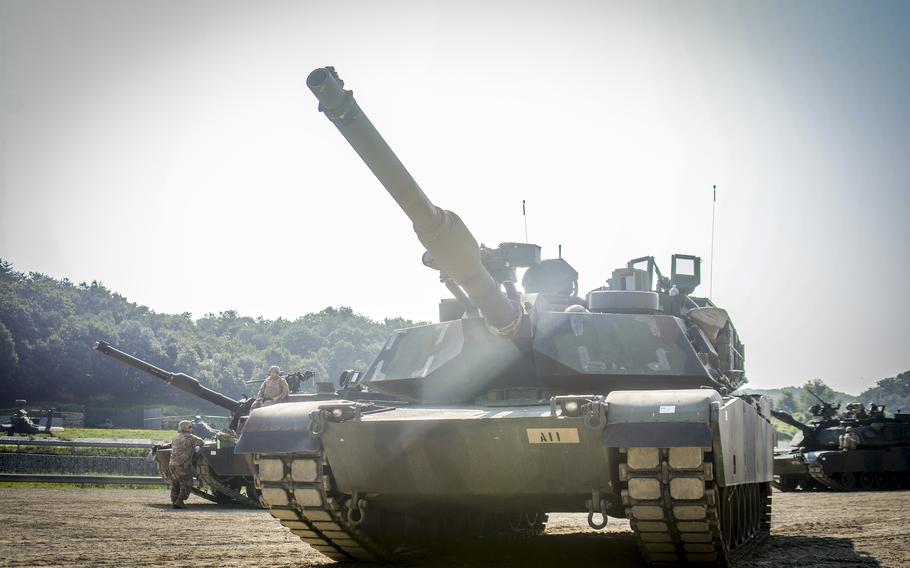
U.S. Army M1A2 Abrams tanks operated by the 1st Armored Brigade Combat Team, part of the 1st Armored Division from Fort Bliss, Texas, stand by for a drill at the Rodriguez Live Fire Complex in Pocheon, South Korea, Aug. 14, 2024. (Luis Garcia/Stars and Stripes)
POCHEON, South Korea — Anti-tank rounds flew from a column of M1A2 Abrams tanks Wednesday at the Rodriguez Live Fire Complex, a short drive from the border with North Korea.
The 1st Armored Brigade Combat Team, part of the 1st Armored Division from Fort Bliss, Texas, was taking part in Operation Pacific Fortitude, a test of the Army’s ability to quickly deploy and defend South Korea in case of war.
Two weeks earlier, the brigade unexpectedly received orders to deploy roughly 800 soldiers to South Korea within 10 days.
Only a handful of soldiers from U.S. Army Forces Command in North Carolina and Eighth Army at Camp Humphreys, South Korea, knew of Pacific Fortitude, and they were only privy to certain details, according to Eighth Army’s director of future planning Col. Denise Little and operations planner Capt. Coty Ruether.
The Forces Command, responsible for combat readiness across the Army, released details of the exercise to planners six months ahead; but the unit involved and the exercise dates were withheld until the final stages “so the unit wouldn’t catch wind,” Little said at Eighth Army headquarters Monday.
Secrecy simulates a real “no-notice alert,” she added.
Spc. Zachary Baker, an M1 armor crewman in the brigade, said he was “pretty excited” to get the surprise notice two weeks ago.
“A lot of us and a few senior members of the unit had actually worked in South Korea so we kind of know the lay of the land,” he said at the range Wednesday. “Even though it was a surprise deployment for us, we were all ready for anything.”
Most of the brigade arrived Aug. 1 throughout South Korea on commercial and military aircraft with their rifles and body armor.
The brigade’s Abrams tanks and M109 Paladin howitzers were left at Fort Bliss, Ruether said.
Instead, the brigade requisitioned military hardware on standby in Daegu city, about 130 miles south of Seoul.
Those tanks and howitzers are the same “go-to-war set” in place should a conflict break out in South Korea, Little said.
“As it’s being used up north during the exercise, as it breaks, the unit is responsible to fix that equipment before they leave,” Ruether said. “The whole point is to have it fixed and ready to go. Once they leave and something happens, that’s the equipment we would draw for an armored brigade.”
Once the brigade familiarized itself with the heavy weapons, they were shipped 160 miles north to the range by train.
Every aspect of the exercise, from the unit’s arrival to shipping the equipment, is timed to mimic a real-world scenario, Ruether explained.
“It’s hard to find a facet of the Army that is not being tested because of this exercise,” he said. “We don’t have the luxury of time, so it’s a good exercise to have.”
The Army learned the lesson of military logistics in South Korea during the 1950-53 Korean War.
The U.S. Far East Command, responsible for military operations in the Pacific at the time, was “unprepared for a ‘come-as-you-are’ war” in South Korea, according to a 1985 U.S. Army War College study.
“As no plans existed to support U.S. combat operations in Korea, [Far East Command] and Eighth Army developed the logistics support system piecemeal from emergency to emergency,” the report said.
Army logisticians have since worked to rectify wartime supply issues and defend South Korea from a potential attack by the North, Ruether said.
“With this now, we have tanks to match tanks,” he said. “When we absorb an initial attack, we have that [equipment] that can be drawn in a week to help defend ourselves, push that equipment up north and to counter that attack.”